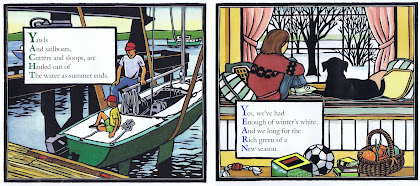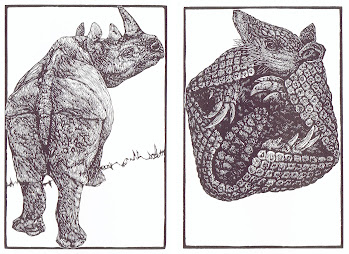Welcome to the April A to Z Blog Challenge! My theme this year is Relief Printed Alphabet Squared, an alphabet of alphabets illustrated with relief block prints. Find the master list of participating blogs here. We may be at the end of the alphabet, but it’s not too late to discover some new blogs.
So, here we are having made it all the way through the alphabet, only to fail at the final hour! I do not have a single block-printed alphabet made by a Z artist, or with a Z theme, or featuring even a single Z word anywhere in the title. What’s a poor abecedarian to do? Zebras, of course. Everyone knows that Z is for Zebra, and as one of the myriad alphabets sampled here expresses in its little verse, alphabets really would be lost without the zebra.
I’ve actually already done a previous post on Z for Zebra, which you can check out for a sampling of Z’s from some of the alphabets mentioned at earlier points in this A to Z (plus a bonus zebra that isn’t part of an alphabet). Then there are all the zebras from their various alphabets that have already appeared in this year’s blog challenge at B, L, R, and W. But even with all that, we’ve barely begun to explore the rich herd of zebras provided
by illustrated alphabets. I start with the zebra from The Good Child’s ABC which was introduced back at G. There may be nothing surprising or remarkable about this one, but I think it’s a good, solid Z, with a well-executed wood engraving for a zebra with plenty of spirit.
Next I threw together a whole herd of little illustrations. They span 200 years of illustrated alphabets, and range from fine wood engravings to rough wood block prints to smooth linoleum block prints. Illustrations 6 and 9 reveal the baffling (and annoying) habit of nineteenth century painters to slosh some color across every zebra, even though the whole essence of zebras is black and white. Illustrations 3 and 7 make the zebra into the shape of its Z. Illustration 5 depicts a mechanical zebra toy rather than a real zebra. Illustration 8 comes from an untitled alphabet book of 1820, that hasn’t had a previous appearance in the A to Z Challenge.
My next group includes zebras with some different personalities. The zebra by Laforge (whose alphabet was introduced at L) is carrying a friendly baby through a bright yellow plain. Lottie Pencheon’s zebra (alphabet introduced at P) shows off her signature simplification. And the last set of zebras, showing a madly galloping band (and also showing that gratuitous yellow paint!), comes from another alphabet that hasn’t previously been featured in this A to Z Challenge. It’s Papa’s Present of Pretty Pictures for Pretty Little People of 1844. (How could I not have featured that one at P? Well, P was already full!)
The final grouping includes a delightful fuzzy zebra by Alan James Robinson, whose alphabets were introduced at R. The others all have a certain oddity. The first is by Walter Inglis Anderson, introduced at A. You’ll notice that the Z is backwards, which implies that he drew his designs directly onto the linoleum and got a little confused! The second, from
Aunt Lely’s Picture Alphabet introduced at L, makes me wonder why the zebra stands in a graveyard. Is it because it has reached the End? And the third, by Lynn Hatzius, introduced at S, is just altogether odd! It’s meant to be making the semaphore sign for Z, but the wrong arms are going in the wrong directions. It should be the the left arm (our right) going straight out to the side, while the right arm (our left) crosses the body at a diagonal.
I guess the first moral of Z is that it’s very easy to get directions mixed up when carving and printing relief block prints!
And also, the journey of 26 letters usually ends with zebras.
So, which of all these wonderful zebras is your favorite? (And feel free to include those in other posts, too. Personally, I’d probably choose the zebra by Jacques Hnizdovsky.) Why does it appeal to you? Which I guess means that I’m asking you what you’d put in your personals ad when you’re looking for a zebra!
[Pictures: Zebra, hand-colored wood engraving from The Good Child’s ABC, between 1847-1867 (Image from University of Washington);
Zebra, wood block print from Hoch-Deutsches Lutherisches ABC, 1840 (Image from Goethe Universität);
Zebra, linocut by Caroline Nuttal Smith, c. 2017 (Image from Etsy shop cnuttalsmith);
Zebra, wood block print from Antonio Frasconi from Bestiary, 1965 (Image from FrasconiArt);
Zebra, wood engraving from The American Indestructible Primer, c. 1880 (Image from University of Florida);
Mechanical Zebra Toy, linocut print by Christopher Brown from An Alphabet of London, 2012;
Zebra, hand-colored woodcut from The Infant’s Nursery Alphabet, 1853 (Image from Toronto Public Libraries);
Zebra, linocut by Mark Long (Image from Typography Daily);
Zebra, hand-colored wood engraving from alphabet booklet, c. 1820 (Image from University of California);
Zebra, wood block print by Joseph Crawhall II from Old Aunt Elspa’s ABC, 1884 (Image from Jospeh Crawhall II society);
Zebre, wood block print with pochoir by Lucien Laforge, 1924 (Image from Mille Feuilles de Bretagne);
Zebra, lino cut print by Lottie Pencheon, c. 2011 (Image from Lottie Pencheon);
Zebra, hand-colored wood engraving from Papa’s Present of Pretty Pictures for Pretty Little People, 1844 (Image from Toronto Public Library);
Zebra, linoleum block print by Walter Inglis Anderson from An Alphabet, 1930’s (Image from WalterAndersonArt);
Z, wood engraving from Aunt Lely’s Picture Alphabet, 1855-62 (Image from University of Washington);
Z, linocut by Lynn Hatzius from A Semaphore Alphabet, 2002 (Image from Books on Books);
Zebra, wood engraving by Alan James Robinson from An Odd Bestiary, 1982.]






















































